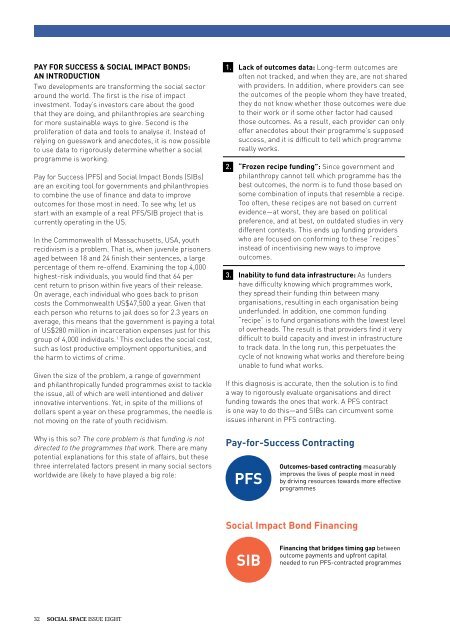Social Space (Issue 8, 2016-2017) - The Social Finance Issue
Since its debut in 2008, Social Space, the bi-annual flagship publication of the Lien Centre for Social Innovation at Singapore Management University, has provided a platform for local and international practitioners and thought leaders to share their perspectives on social innovation and entrepreneurship. Available in print and online (http://www.socialspacemag.org).
Since its debut in 2008, Social Space, the bi-annual flagship publication of the Lien Centre for Social Innovation at Singapore Management University, has provided a platform for local and international practitioners and thought leaders to share their perspectives on social innovation and entrepreneurship. Available in print and online (http://www.socialspacemag.org).
Create successful ePaper yourself
Turn your PDF publications into a flip-book with our unique Google optimized e-Paper software.
PAY FOR SUCCESS & SOCIAL IMPACT BONDS:<br />
AN INTRODUCTION<br />
Two developments are transforming the social sector<br />
around the world. <strong>The</strong> first is the rise of impact<br />
investment. Today’s investors care about the good<br />
that they are doing, and philanthropies are searching<br />
for more sustainable ways to give. Second is the<br />
proliferation of data and tools to analyse it. Instead of<br />
relying on guesswork and anecdotes, it is now possible<br />
to use data to rigorously determine whether a social<br />
programme is working.<br />
Pay for Success (PFS) and <strong>Social</strong> Impact Bonds (SIBs)<br />
are an exciting tool for governments and philanthropies<br />
to combine the use of finance and data to improve<br />
outcomes for those most in need. To see why, let us<br />
start with an example of a real PFS/SIB project that is<br />
currently operating in the US.<br />
In the Commonwealth of Massachusetts, USA, youth<br />
recidivism is a problem. That is, when juvenile prisoners<br />
aged between 18 and 24 finish their sentences, a large<br />
percentage of them re-offend. Examining the top 4,000<br />
highest-risk individuals, you would find that 64 per<br />
cent return to prison within five years of their release.<br />
On average, each individual who goes back to prison<br />
costs the Commonwealth US$47,500 a year. Given that<br />
each person who returns to jail does so for 2.3 years on<br />
average, this means that the government is paying a total<br />
of US$280 million in incarceration expenses just for this<br />
group of 4,000 individuals. 1 This excludes the social cost,<br />
such as lost productive employment opportunities, and<br />
the harm to victims of crime.<br />
Given the size of the problem, a range of government<br />
and philanthropically funded programmes exist to tackle<br />
the issue, all of which are well intentioned and deliver<br />
innovative interventions. Yet, in spite of the millions of<br />
dollars spent a year on these programmes, the needle is<br />
not moving on the rate of youth recidivism.<br />
Why is this so? <strong>The</strong> core problem is that funding is not<br />
directed to the programmes that work. <strong>The</strong>re are many<br />
potential explanations for this state of affairs, but these<br />
three interrelated factors present in many social sectors<br />
worldwide are likely to have played a big role:<br />
1. Lack of outcomes data: Long-term outcomes are<br />
often not tracked, and when they are, are not shared<br />
with providers. In addition, where providers can see<br />
the outcomes of the people whom they have treated,<br />
they do not know whether those outcomes were due<br />
to their work or if some other factor had caused<br />
those outcomes. As a result, each provider can only<br />
offer anecdotes about their programme’s supposed<br />
success, and it is difficult to tell which programme<br />
really works.<br />
2. “Frozen recipe funding”: Since government and<br />
philanthropy cannot tell which programme has the<br />
best outcomes, the norm is to fund those based on<br />
some combination of inputs that resemble a recipe.<br />
Too often, these recipes are not based on current<br />
evidence—at worst, they are based on political<br />
preference, and at best, on outdated studies in very<br />
different contexts. This ends up funding providers<br />
who are focused on conforming to these “recipes”<br />
instead of incentivising new ways to improve<br />
outcomes.<br />
3. Inability to fund data infrastructure: As funders<br />
have difficulty knowing which programmes work,<br />
they spread their funding thin between many<br />
organisations, resulting in each organisation being<br />
underfunded. In addition, one common funding<br />
“recipe” is to fund organisations with the lowest level<br />
of overheads. <strong>The</strong> result is that providers find it very<br />
difficult to build capacity and invest in infrastructure<br />
to track data. In the long run, this perpetuates the<br />
cycle of not knowing what works and therefore being<br />
unable to fund what works.<br />
If this diagnosis is accurate, then the solution is to find<br />
a way to rigorously evaluate organisations and direct<br />
funding towards the ones that work. A PFS contract<br />
is one way to do this—and SIBs can circumvent some<br />
issues inherent in PFS contracting.<br />
Pay-for-Success Contracting<br />
PFS<br />
Outcomes-based contracting measurably<br />
improves the lives of people most in need<br />
by driving resources towards more effective<br />
programmes<br />
<strong>Social</strong> Impact Bond Financing<br />
SIB<br />
Financing that bridges timing gap between<br />
outcome payments and upfront capital<br />
needed to run PFS-contracted programmes<br />
32 <strong>Social</strong> <strong>Space</strong> ISSUE EIGHT


